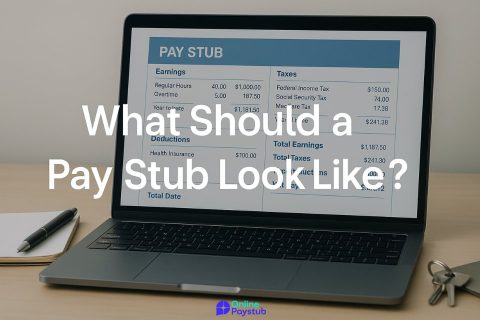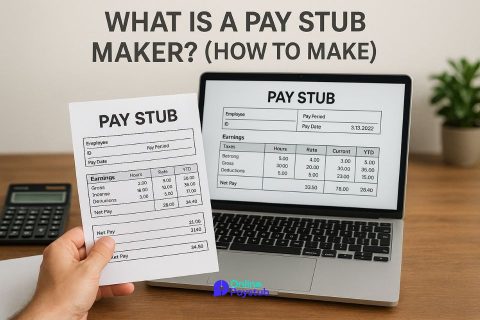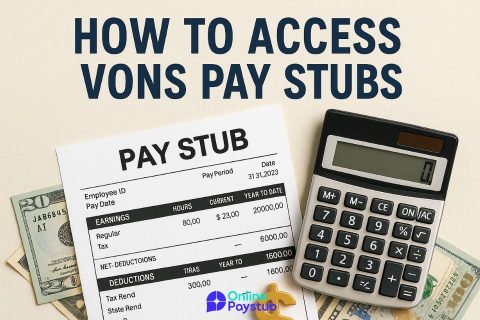A pay stub is a document that outlines the details of a worker’s earnings for a specific period. It typically includes gross income, deductions, net pay, and other compensation-related data. For employees, these records are automatically issued by employers. For independent contractors, however, the responsibility of tracking earnings and documenting payment details falls entirely on their shoulders.
At Online Pay Stubs, we understand how important it is for contractors to have access to clear, reliable income documentation. Even though issuing pay stubs to 1099 contractors isn’t mandated by law, having one is often essential. Whether applying for a loan, renting a property, or verifying income for tax purposes, contractors are frequently asked to provide formal proof of earnings. And in many cases, informal invoices or transaction records simply aren’t enough.
That’s why we’ve built our pay stub generation tool specifically for independent contractors. With our platform, you can produce detailed, professional-grade pay stubs in just a few minutes pay stubs that reflect exactly what you earned, how, and when. These documents offer a standardized, trustworthy format accepted by financial institutions, tax professionals, and clients alike.
We help you stay financially organized and legally prepared. By tracking each project’s income with precision, you minimize risk, support accurate tax filings, and build stronger financial credibility. Whether you’re a full-time freelancer or juggling multiple short-term contracts, our solution gives you control over your pay records simply, securely, and on your terms.
Can Independent Contractors Legally Receive Pay Stubs?
Yes, independent contractors can legally receive pay stubs even though there’s no legal obligation for clients to issue them. In fact, generating your own pay stubs is not only legal, it’s highly recommended.
The Internal Revenue Service (IRS) does not require pay stubs for 1099 contractors. Instead, it mandates that clients issue IRS Form 1099-NEC if total annual payments exceed $600. This form summarizes the total amount paid to a contractor in a tax year, but it does not include specific pay periods, hourly rates, or deductions. That’s where pay stubs become useful.
As independent contractors are classified as self-employed, they are responsible for documenting and reporting their income. Without access to traditional payroll systems, they often face challenges when needing to verify income in a standardized format. That’s why we built Online Pay Stubs to give you the ability to generate legally valid pay documentation that mirrors the structure of what employees receive.
By using our tool, you can create fully compliant pay stubs that include all necessary information: contractor and company details, gross income, pay period, pay date, and optional deductions. Our pay stubs aren’t just for internal tracking; they are structured to be accepted by banks, lenders, and tax professionals.
While pay stubs aren’t required under labor laws for independent contractors, nothing prevents you from creating them and doing so enhances your financial transparency and professionalism. With our platform, you’re empowered to take control of your income documentation in a way that aligns with regulatory expectations and real-world needs.
What Information Should a 1099 Pay Stub Include?
A well-prepared 1099 pay stub is more than a simple payment note it is a structured financial document designed to reflect the full details of a contractor’s compensation. To ensure clarity, professionalism, and usability in financial settings, there are key elements that every contractor pay stub should include.
At Online Pay Stubs, we’ve designed our generator to walk you through each of these fields so you don’t miss anything critical. Here’s what a compliant and useful pay stub typically contains:
1. Contractor Information
Your full name, business name (if applicable), mailing address, and tax identification number (SSN or EIN). This data ensures proper identification and alignment with IRS reporting.
2. Company Details
The name and address of the client or payer. Including this information supports audit readiness and adds formal legitimacy to the document.
3. Pay Period and Payment Date
Clearly state the dates covered by the payment and the exact date the payment was made. Our tool allows you to input both current and retroactive periods with ease.
4. Gross Earnings
The total compensation before deductions, based on your agreed rate and hours worked or per-project pricing. You can itemize earnings across multiple jobs within the same pay period.
5. Additional Earnings or Adjustments
If you received bonuses, expense reimbursements, or other forms of supplemental income, these should be recorded separately. We enable full customization to reflect these variables.
6. Deductions (Optional)
Although contractors are responsible for their own taxes, some choose to show estimated federal, state, or self-employment tax deductions. You can include them in our tool to reflect a more realistic net income view.
7. Year-to-Date (YTD) Totals
Tracking cumulative earnings and deductions for the calendar year adds consistency and helps when reconciling quarterly or annual tax reports. Our system calculates YTD values automatically.
8. Net Pay
The final amount you retain after deductions, if any are included. This figure is often what lenders or financial institutions focus on when reviewing pay stubs.
We’ve built Online Pay Stubs to make sure every stub you generate includes these essential data points accurately, securely, and professionally. This not only helps you stay compliant but also positions you to confidently present proof of income wherever it’s needed.
Step-by-Step: How We Help You Generate a Pay Stub for Contractors
Creating a pay stub shouldn’t require accounting knowledge or complex software. At Online Pay Stubs, we’ve streamlined the process so that independent contractors can generate accurate, professional-grade pay stubs in minutes even with irregular income and multiple clients.
Here’s how we guide you through each step:
Step 1: Enter Company Information
Start by adding the name, address, and EIN (Employer Identification Number) of the company issuing the payment. If you’re generating a pay stub for yourself, this may be your client or your own business entity.
Step 2: Add Contractor Details
Input your name, SSN or EIN, and current mailing address. This ensures the pay stub accurately reflects your personal tax profile and matches official records.
Step 3: Choose a Template and Customize It
We offer multiple pay stub templates designed to match industry standards. You can add your logo, adjust the layout, and select the design that best fits your professional needs.
Step 4: Input Earnings and Pay Period Data
Specify your hourly rate or flat project fee, and indicate the number of hours worked or tasks completed. Then select the corresponding pay period and payday. Our system instantly calculates total earnings for that period.
Step 5: Add Deductions and Additional Earnings
Include reimbursements, bonuses, or other income sources. If desired, you can also reflect estimated tax deductions or retirement contributions to simulate net income.
Step 6: Review Year-to-Date (YTD) Values
Our generator supports year-to-date calculations to help you track cumulative earnings and deductions. This is particularly valuable for quarterly tax estimates and annual financial reporting.
Step 7: Preview, Edit, and Finalize
Before finalizing, we allow you to preview the full pay stub. You can make adjustments instantly and ensure every detail is accurate.
Step 8: Download or Send Instantly
Once confirmed, download the pay stub as a PDF or send it directly via email. Whether you’re submitting it to a lender or storing it for your own records, your pay stub will be ready in moments.
With our platform, there’s no need to rely on spreadsheets or third-party software. We give you full control without the complexity. Everything is structured for compliance, clarity, and ease of use, so you can focus on your work, not paperwork.
Why Choose Our Online Tool to Generate Pay Stubs for Contractors?
Independent contractors operate without the structural support of an employer’s payroll department. They manage their own income, taxes, documentation, and financial records often across multiple clients and inconsistent payment cycles. For these professionals, having a reliable, efficient, and accurate way to document earnings is not a luxury it’s a necessity.
That’s exactly why we created Online Pay Stubs.
Our tool is built for contractors. Whether you’re a freelance graphic designer, a self-employed consultant, a delivery driver, or a contract-based technician, you need a way to prove income that’s clear, professional, and acceptable across financial contexts. Our generator delivers exactly that.
Here’s what sets us apart:
Tailored for Independent Contractors
We understand the variability in freelance income. That’s why our tool lets you fully customize hours, project rates, bonus earnings, and YTD values without rigid payroll structures.
Instant, Accurate, and Fully Editable
You can generate a complete pay stub in under two minutes. Preview it before finalizing, make corrections instantly, and update values as needed. No software installations or accounting experience required.
Professional Templates That Reflect Real Income
Our templates are designed to meet the expectations of banks, landlords, tax preparers, and other institutions that require proof of income. They go beyond basic invoices by showing structured, itemized earnings that enhance credibility.
First Pay Stub Free
We offer your first pay stub at no cost. It’s our way of making sure you can try the tool and see the results before committing to anything further.
Ongoing Access and History
Track previous pay periods, view past stubs, and maintain a complete digital archive all in one place. It’s perfect for quarterly tax estimates, loan applications, or any situation where consistent documentation matters.
We built this tool with one goal in mind: to make it easy for independent contractors to manage their income like a professional without needing an accountant, a payroll provider, or expensive software.
You focus on your work. We’ll handle the paperwork.




No comments to show.